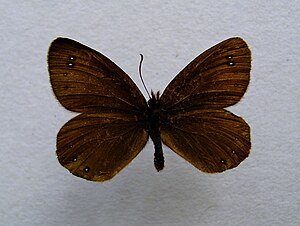Eismusfalter
| Eismusfalter | ||||||||||||
|---|---|---|---|---|---|---|---|---|---|---|---|---|

Eiskurfalter ( Erebia pluto ) |
||||||||||||
| Systematics | ||||||||||||
|
||||||||||||
| Scientific name | ||||||||||||
| Erebia pluto | ||||||||||||
| ( Prunner , 1798) |
The Eismohrenfalter ( Erebia pluto ) is a butterfly (day butterfly ) from the family of the noble butterfly (Nymphalidae).
features
butterfly
The front wings of the moths, which have a wingspan of about 32 to 40 millimeters, are dark brown in color and show a silky, sometimes slightly green or bluish sheen. They vary in color depending on the local geographic occurrence. So almost monochrome dark brown, almost black specimens occur, which only show two small white centered eye spots on the forewings. Other butterflies have a red-brown band in the post -disk region. The underside of the forewings is often a single color, dark reddish brown with translucent white eye spots, only occasionally reddish tints emerge more clearly. As a rule, no bandage can be seen on the dark brown hind wings. The hind wing undersides are dark brown and without clear markings.
Egg, caterpillar, pupa
The oval egg is yellowish in color and has fine longitudinal ribs. The adult caterpillars are dominated by a gray color, which is interrupted by dark green back and yellowish side lines. The red-brown colored doll is often covered with a bluish or greenish hoop.
Similar species
Although there is a certain similarity to other species of black butterflies, pluto is usually less drawn and darker in color and can also be easily recognized by its typical, gliding style of flight over very high scree fields.
distribution and habitat
The Eismo Eismo Eternal Butterfly occurs in high altitudes of the Alps and Apennines predominantly between 1900 and 3000 meters. It prefers rocky slopes with little vegetation, limestone scree slopes, rubble-covered cirques and coarse scree slopes up to the edge of ice and snow fields.
Way of life
The moths live in one generation from June to August. The males are extremely elegant fliers and glide in characteristic soaring flight together with the silky-gloss moth ( Erebia gorge ) over scree fields in search of the females, who usually sit quietly between large boulders. The sailing style of flight is reminiscent of that of the Alpine Apollo ( Parnassius phoebus ). The females prefer to lay the eggs one by one on rocks and stones. The main forage plants of the caterpillars are fescue species ( Festuca ) as well as annual bluegrass ( Poa annua ) and small bluegrass ( Poa minor ). Pupation takes place in a wide-meshed, loose web under stones.
Danger
In Germany, the species occurs only in a few places in the Bavarian Alps and is listed on the Red List of Endangered Species in Category R (species with geographical restriction).
swell
Individual evidence
- ↑ Walter Forster, Theodor A. Wohlfahrt: The butterflies of Central Europe. Volume 2: Butterflies. (Rhopalocera and Hesperiidae). Franckh'sche Verlagshandlung, Stuttgart 1955, DNB 456642188 .
- ^ Erebia pluto ecology, Wolfgang Wagner 2005-2019
- ↑ DH Frhr. von der Goltz: Die Erebien (Lepidopt.) Alfred Kernen Verlag, Stuttgart 1935
- ↑ Tom Tolman, Richard Lewington: The butterflies of Europe and Northwest Africa . Franckh-Kosmos, Stuttgart 1998, ISBN 3-440-07573-7 .
- ↑ Federal Agency for Nature Conservation (Ed.): Red List of Endangered Animals in Germany . Landwirtschaftsverlag, Münster 1998, ISBN 3-89624-110-9 .
literature
- Tom Tolman, Richard Lewington: The butterflies of Europe and Northwest Africa . Franckh-Kosmos, Stuttgart 1998, ISBN 3-440-07573-7 .
- Walter Forster , Theodor A. Wohlfahrt : The butterflies of Central Europe. Volume 2: Butterflies. (Rhopalocera and Hesperiidae). Franckh'sche Verlagshandlung, Stuttgart 1955, DNB 456642188 .
Web links
- Lepiforum e. V. Taxonomy and Photos
- www.pyrgus.de Photos
- www.schmetterlinge-deutschlands.de Endangerment
- Erebia pluto at Fauna Europaea
- Erebia pluto inthe IUCN 2013 Red List of Threatened Species . Posted by: van Swaay, C., Wynhoff, I., Verovnik, R., Wiemers, M., López Munguira, M., Maes, D., Sasic, M., Verstrael, T., Warren, M. & Settele, J., 2009. Retrieved February 18, 2014.
